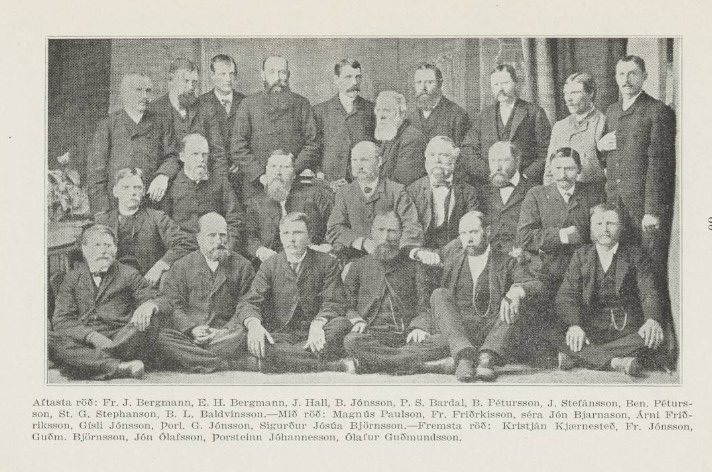From the Pulpit to the Page
The church was at the forefront of Icelandic community life in North America. Thus, it had major influence on the history of Icelandic publishing in Manitoba. The early religious dispute in New Iceland, for example, contributed to the ending of Framfari. There is also no surprise that the first Icelandic magazine published in the province was religious-themed.
The first issue of Sameiningin, the Icelandic Lutheran’s Synod’s monthly magazine, appeared in March 1886. It was produced in Winnipeg and edited by Reverend Jón Bjarnason, who moved to Winnipeg in 1884 to serve as minister of the city’s First Lutheran Church. Sameiningin’s contents included sermons, short articles, poems, and other religious writings. The magazine operated largely as a platform for Jón to circulate his thoughts and views.
In 1891, a critical event changed the course of religious life among the Icelanders. Reverend Magnús J. Skaptason arrived four years earlier to minister to six Lutheran parishes in New Iceland. In early 1891, he delivered a series of sermons rejecting several Lutheran tenets, including the doctrines of hell, eternal punishment, and the inerrancy of the Bible. The controversy led to Rev. Magnús’ resignation.
Rev. Magnús and his followers eventually joined the Unitarian church, which also became the home for many of Heimskringla’s readers. In January 1893, Magnús launched Dagsbrún, a monthly Unitarian magazine. It was first published in Gimli but later moved to Winnipeg before ceasing publication in 1896. The monthly Unitarian magazine Heimir was published in Winnipeg between 1904 and 1914. Its first and longest serving editor was Rev. Rögnvaldur Pétursson.
Another controversy rocked the Icelandic Lutheran church in Winnipeg a few years later. In 1902, Reverend Friðrik J. Bergmann became minister of the city’s second Lutheran congregation. Four years later, in 1906, he produced the first issue of the new monthly magazine Breiðablik. Its aim was to promote the so-called “New Theology,” which Jón and others in the Synod strongly opposed.
Jón and Friðrik expressed their sides of the religious dispute through the pages of Sameiningin and Breiðablik. Consequently, in 1909, Friðrik and nearly one third of its 7,000 members withdrew from the Icelandic Lutheran Synod. However, Friðrik’s new congregation faced many organizational struggles. They eventually amalgamated with the Unitarian church while some rejoined the Icelandic Lutheran Synod.
The publication of Breiðablik ceased in 1914, and Rev. Friðrik died four years later. Rev. Jón died in 1914, but Sameiningin continued to be published until 1964. Other notable Icelandic religious magazines published in Manitoba over the years include Aldamót (1891–1903), Ný dagsbrún (1904–1906), Stjarnan (1919–1956), Árdís (1933–1966), and Brautin (1944–1952).
The history of religion in the Icelandic migrant community and the history of Icelandic publishing in Manitoba are deeply interwoven. Religious-themed magazines provided a platform to discuss faith and offered space for religious instruction and reflection. They also document the many changes, disputes, and divisions that took place over the years, which reached all corners of the Icelandic community in North America.






